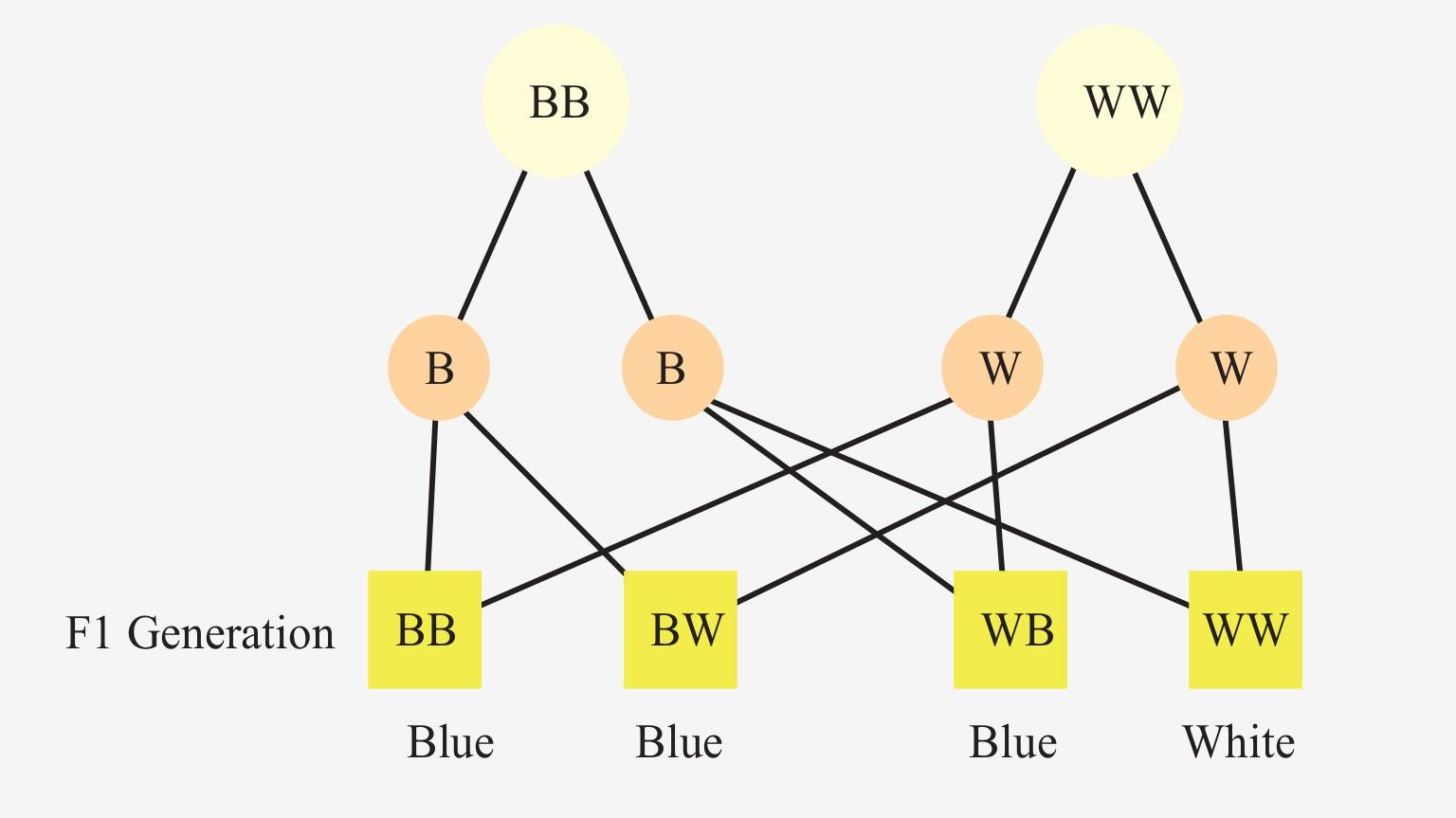
Answer
424.8k+ views
Hint: The ${ F }_{ 1 }$ generation is self-pollinated, therefore there's no change in traits in this generation. The${ F }_{ 2 }$ is carried out by cross-pollination with the white flowers so both colored flowers will appear in this generation.
Complete answer:
If the flowers of ${ F }_{ 1 }$ plants were selfed, the diagram below will represent the ${ F }_{ 2 }$ generation:

Therefore, from the diagram we get,
The F2 generation will be of 3 blue and 1 white flower. Therefore, the ratio will be a blue flower: white flower = 3:1.
Now,
The percentage of white flowers in the F2 generation is
Percentage $=\frac { No. \ of \ white \ flower \ plants }{ Total \ plants \ in \ { F }_{ 2 } \ generation } \times \ 100$
Percentage $=\frac { 1 }{ 4 } \times 100$
So, the percentage will be $25\%$.
Note:
- When purebred organisms of two different species are bred to give rise to a new type of animal or plant it is known as crossbreeding. It is used to create higher quality animals or plants with vitality and good health, sometimes irresponsible crossbreeding may cause deterioration of quality as well. In animal breeding, when the breeding is between single species it is called crossbreeds whereas in different species it is known as hybrids. But in the case of plants, these two terms are not distinguishable.
- When the stamen of a flower lands on the same flower's stigma during pollination it is called selfed or self-pollination. The term selfed is not restricted to self-pollination though, it can be referred to as self-fertilization as well. Self-pollination can be helpful in some cases such as keeping certain traits in the progenies stable. When there's no pollinating agent, the plants still need to carry out reproduction. In such a case, self-pollination can be a way to solve this problem. Also, there's less wastage of pollen during this process.
Complete answer:
If the flowers of ${ F }_{ 1 }$ plants were selfed, the diagram below will represent the ${ F }_{ 2 }$ generation:

Therefore, from the diagram we get,
The F2 generation will be of 3 blue and 1 white flower. Therefore, the ratio will be a blue flower: white flower = 3:1.
Now,
The percentage of white flowers in the F2 generation is
Percentage $=\frac { No. \ of \ white \ flower \ plants }{ Total \ plants \ in \ { F }_{ 2 } \ generation } \times \ 100$
Percentage $=\frac { 1 }{ 4 } \times 100$
So, the percentage will be $25\%$.
Note:
- When purebred organisms of two different species are bred to give rise to a new type of animal or plant it is known as crossbreeding. It is used to create higher quality animals or plants with vitality and good health, sometimes irresponsible crossbreeding may cause deterioration of quality as well. In animal breeding, when the breeding is between single species it is called crossbreeds whereas in different species it is known as hybrids. But in the case of plants, these two terms are not distinguishable.
- When the stamen of a flower lands on the same flower's stigma during pollination it is called selfed or self-pollination. The term selfed is not restricted to self-pollination though, it can be referred to as self-fertilization as well. Self-pollination can be helpful in some cases such as keeping certain traits in the progenies stable. When there's no pollinating agent, the plants still need to carry out reproduction. In such a case, self-pollination can be a way to solve this problem. Also, there's less wastage of pollen during this process.
Recently Updated Pages
How many sigma and pi bonds are present in HCequiv class 11 chemistry CBSE

Mark and label the given geoinformation on the outline class 11 social science CBSE

When people say No pun intended what does that mea class 8 english CBSE

Name the states which share their boundary with Indias class 9 social science CBSE

Give an account of the Northern Plains of India class 9 social science CBSE

Change the following sentences into negative and interrogative class 10 english CBSE

Trending doubts
Which are the Top 10 Largest Countries of the World?

Fill the blanks with the suitable prepositions 1 The class 9 english CBSE

How do you graph the function fx 4x class 9 maths CBSE

The Equation xxx + 2 is Satisfied when x is Equal to Class 10 Maths

One Metric ton is equal to kg A 10000 B 1000 C 100 class 11 physics CBSE

Give 10 examples for herbs , shrubs , climbers , creepers

Differentiate between homogeneous and heterogeneous class 12 chemistry CBSE

Difference between Prokaryotic cell and Eukaryotic class 11 biology CBSE

Why is there a time difference of about 5 hours between class 10 social science CBSE



